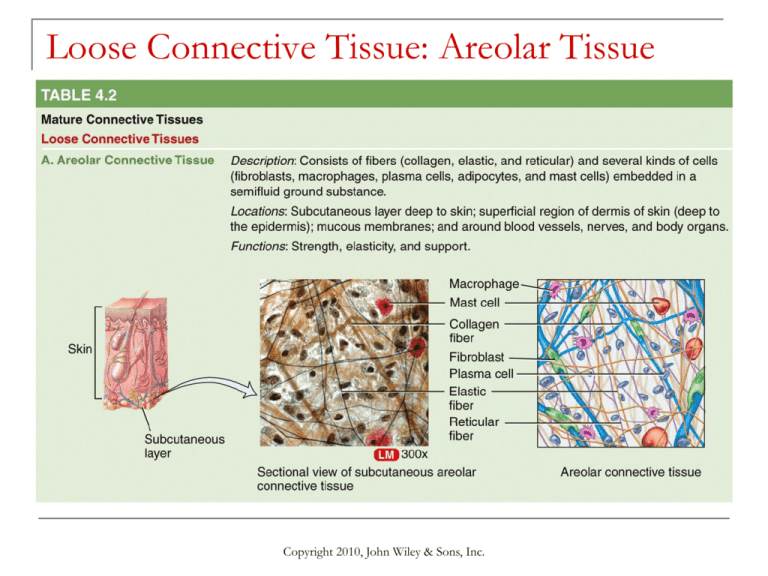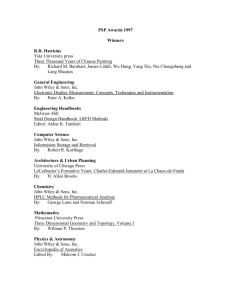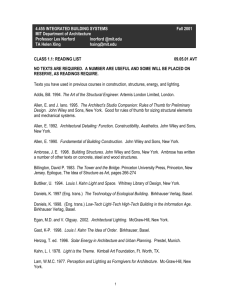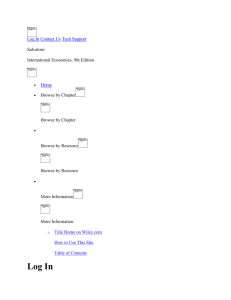
Loose Connective Tissue: Areolar Tissue
Copyright 2010, John Wiley & Sons, Inc.
Loose Connective Tissue: Adipose Tissue
Copyright 2010, John Wiley & Sons, Inc.
Loose Connective Tissue: Reticular Tissue
Copyright 2010, John Wiley & Sons, Inc.
Dense Connective Tissue: Dense Regular
Connective Tissue
Copyright 2010, John Wiley & Sons, Inc.
Dense Connective Tissue: Dense Irregular
Connective Tissue
Copyright 2010, John Wiley & Sons, Inc.
Dense Connective Tissue: Elastic Connective
Tissue
Copyright 2010, John Wiley & Sons, Inc.
Cartilage: Hyaline Cartilage
Copyright 2010, John Wiley & Sons, Inc.
Cartilage: Fibrocartilage
Copyright 2010, John Wiley & Sons, Inc.
Cartilage: Elastic Cartilage
Copyright 2010, John Wiley & Sons, Inc.
Osseous Tissue: Compact Bone
Copyright 2010, John Wiley & Sons, Inc.
Liquid Connective Tissue: Blood
Copyright 2010, John Wiley & Sons, Inc.
Membranes = Thin Sheets of Cells/Simple Organs
Thin sheets of flexible tissue that line or cover parts of the
body are called membranes.
Epithelial membranes contain an epithelium and an
underlying connective tissue:
mucous membranes
serous membranes
cutaneous membrane
Synovial membranes contain only connective tissues, and
line the cavities of synovial joints
Copyright 2010, John Wiley & Sons, Inc.
Mucous Membranes (or Mucosa)
Mucous membranes line body cavities open to the outside
mucosa are important in preventing infection of the body
The epithelial layer secretes mucus, a thick slippery fluid
The epithelium rests on an areolar tissue layer, the lamina
propria
Copyright 2010, John Wiley & Sons, Inc.
Mucous Membranes (or Mucosa)
Copyright 2010, John Wiley & Sons, Inc.
Serous Membranes
Serous membranes cover the surface of organs that are
not exposed to the outside, and secrete a watery fluid
Serous membranes have two layers:
the parietal layer attaches to the body wall around the
organ
the visceral layer attaches to the organs themselves
Prominent examples: the pleura surround the lungs, the
pericardium surrounds the heart, peritoneum in
abdomen
Copyright 2010, John Wiley & Sons, Inc.
Serous Membranes
Copyright 2010, John Wiley & Sons, Inc.
Cutaneous Membrane and Synovial Membrane
The cutaneous membrane is the skin, covering the outer
surface of the body
Synovial membranes line the cavities of freely movable joints,
and contain only connective tissues
Copyright 2010, John Wiley & Sons, Inc.
Cutaneous Membrane and Synovial Membrane
Copyright 2010, John Wiley & Sons, Inc.
Muscle Tissue: Skeletal Muscle Tissue
Copyright 2010, John Wiley & Sons, Inc.
Muscle Tissue: Cardiac Muscle Tissue
Copyright 2010, John Wiley & Sons, Inc.
Muscle Tissue: Smooth Muscle Tissue
Copyright 2010, John Wiley & Sons, Inc.
Nervous Tissue
Nervous tissue is highly variable and complex, it
includes two broad groups of cells:
neurons collect, send and receive, and process
information
neuroglial cells nourish and protect the neurons
Copyright 2010, John Wiley & Sons, Inc.
Nervous Tissue
Copyright 2010, John Wiley & Sons, Inc.
Healing of Injured Tissues
Tissue repair is required when cells die due to injury, or when
cells get old and “wear out”
Different tissues vary considerably in their capacity for repair
Replacement of damaged cells depends on:
cell division (of stem cells or migrating cells) to create new cells
differentiation of the new cells to their mature phenotype
Healing of tissues is very dependent on their blood supply,
and on adequate nutrition
Copyright 2010, John Wiley & Sons, Inc.
End of Chapter 4
Copyright 2010 John Wiley & Sons, Inc.
All rights reserved. Reproduction or translation of this work
beyond that permitted in section 117 of the 1976 United States
Copyright Act without express permission of the copyright owner
is unlawful. Request for further information should be addressed
to the Permission Department, John Wiley & Sons, Inc. The
purchaser may make back-up copies for his/her own use only
and not for distribution or resale. The Publishers assumes no
responsibility for errors, omissions, or damages caused by the
use of theses programs or from the use of the information herein.
Copyright 2010, John Wiley & Sons, Inc.







